Monthly Archives: November 2020
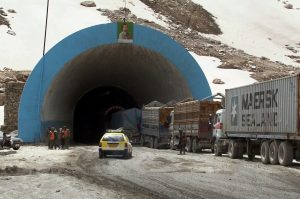 Sometimes when a vehicle accident occurs, one or both vehicles catch on fire. It is almost to be expected periodically, but it is almost never expected to be catastrophic. Nevertheless, on November 2, 1982, such an accident occurred in the Salang Tunnel in Afghanistan, and it cost 3,000 people their lives. Most of the victims were Soviet soldiers traveling to Kabul.
Sometimes when a vehicle accident occurs, one or both vehicles catch on fire. It is almost to be expected periodically, but it is almost never expected to be catastrophic. Nevertheless, on November 2, 1982, such an accident occurred in the Salang Tunnel in Afghanistan, and it cost 3,000 people their lives. Most of the victims were Soviet soldiers traveling to Kabul.
The entrance into Afghanistan by the Soviet Union that year was disastrous in nearly every way, but possibly the worst single incident was the Salang Tunnel explosion. At the time of the crash, a long army convoy was traveling from Russia to Kabul through the border city of Hairotum. The route took the convoy through the Salang Tunnel, which is 1.7 miles long, 25 feet high and approximately 17 feet wide. The tunnel is one of the world’s highest at an altitude of 11,000 feet. It was built by the Soviets in the 1970s.
As was common in those days, the Soviet army kept a tight lid on the story. It is believed that an army vehicle 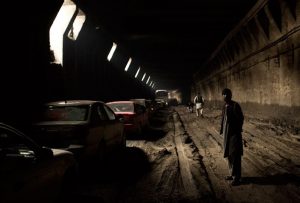 collided with a fuel truck about half way through the long tunnel. When the fuel truck exploded, about 30 buses carrying soldiers were immediately blown up. Fire in the tunnel spread quickly and the survivors of the blast began to panic. The ensuing chaos made the military stationed at the ends of the tunnel believe the explosion was part of an attack. As per protocol for terrorist attacks, the military stationed at both ends of the tunnel stopped traffic from exiting. If the fire wasn’t enough, the idling cars in the tunnel caused the levels of carbon monoxide in the air to increase drastically, The fire continued to spread as well. Exacerbating the situation, the tunnel’s ventilation system had broken down a couple of days earlier, resulting in further casualties from burns and carbon monoxide poisoning.
collided with a fuel truck about half way through the long tunnel. When the fuel truck exploded, about 30 buses carrying soldiers were immediately blown up. Fire in the tunnel spread quickly and the survivors of the blast began to panic. The ensuing chaos made the military stationed at the ends of the tunnel believe the explosion was part of an attack. As per protocol for terrorist attacks, the military stationed at both ends of the tunnel stopped traffic from exiting. If the fire wasn’t enough, the idling cars in the tunnel caused the levels of carbon monoxide in the air to increase drastically, The fire continued to spread as well. Exacerbating the situation, the tunnel’s ventilation system had broken down a couple of days earlier, resulting in further casualties from burns and carbon monoxide poisoning.
Rescue and recovery was slow due to the lack of safe working conditions for rescue crews. It took several days for workers to reach all the bodies in the tunnel. To make matters worse, the Soviet army limited the 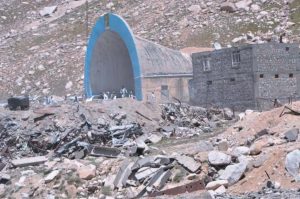 information released about the disaster, so we may never know the full extent of the tragedy. While the fire and carbon monoxide poisonings were tragic in and of themselves, the fact that the military thought the accident might be a terrorist attack, really caused the massive amounts of death. The people in the tunnel were trapped, and there was no ventilation. They couldn’t get away from the death enveloping them on all sides. I’m sure there was panic and screaming, making the chaos even worse. The very thought of all those people trapped in that tunnel makes me feel nauseous, and I’m sure that if the Soviets kept it under wraps, there were families who never knew what happened to their loved ones.
information released about the disaster, so we may never know the full extent of the tragedy. While the fire and carbon monoxide poisonings were tragic in and of themselves, the fact that the military thought the accident might be a terrorist attack, really caused the massive amounts of death. The people in the tunnel were trapped, and there was no ventilation. They couldn’t get away from the death enveloping them on all sides. I’m sure there was panic and screaming, making the chaos even worse. The very thought of all those people trapped in that tunnel makes me feel nauseous, and I’m sure that if the Soviets kept it under wraps, there were families who never knew what happened to their loved ones.
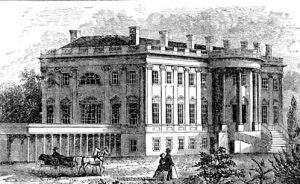 It was a long time coming. An actual house for the President of the United States was a long time coming. Prior to establishing the nation’s capital in Washington DC, the United States Congress and its predecessors had met in Philadelphia (Independence Hall and Congress Hall), New York City (Federal Hall), and a number of other locations (York, Pennsylvania; Lancaster, Pennsylvania; the Maryland State House in Annapolis, Maryland; and Nassau Hall in Princeton, New Jersey). Then, it was decided that our government needed a permanent home. Washington DC was selected.
It was a long time coming. An actual house for the President of the United States was a long time coming. Prior to establishing the nation’s capital in Washington DC, the United States Congress and its predecessors had met in Philadelphia (Independence Hall and Congress Hall), New York City (Federal Hall), and a number of other locations (York, Pennsylvania; Lancaster, Pennsylvania; the Maryland State House in Annapolis, Maryland; and Nassau Hall in Princeton, New Jersey). Then, it was decided that our government needed a permanent home. Washington DC was selected.
The first president who would have an actual government-owned home in Washington DC was President John Adams, and he would only live there for the last year of his only term in office. President John Adams, in the last year of his only term as president, moved into the newly constructed President’s House on November 1, 1800. The President’s House was the original name for what is known today as the White House. Adams and his wife had been living in temporarily at Tunnicliffe’s City Hotel near the half-finished Capitol building since June 1800, when the federal government 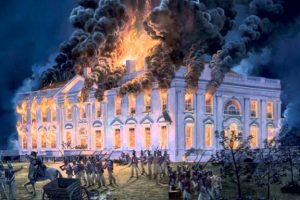 was moved from Philadelphia to the new capital city of Washington DC. When Adams first arrived in Washington, he wrote to his wife Abigail, who was still at their home in Quincy, Massachusetts, that he was pleased with the new site for the federal government and that he had explored the soon-to-be President’s House and liked it.
was moved from Philadelphia to the new capital city of Washington DC. When Adams first arrived in Washington, he wrote to his wife Abigail, who was still at their home in Quincy, Massachusetts, that he was pleased with the new site for the federal government and that he had explored the soon-to-be President’s House and liked it.
Although workmen had rushed to finish plastering and painting walls before Adams returned to DC from a visit to Quincy in late October, the construction was still unfinished when Adams rolled up in his carriage on November 1. However, the furniture from their Philadelphia home was in place and a portrait of George Washington was already hanging in one room. It was a decent start. The next day, Adams sent a note to Abigail, who would arrive in Washington later that month, saying that he hoped “none but honest and wise men [shall] ever rule under this roof.” I wish that 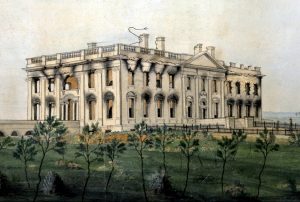 had always been the case, and of course the idea of good and bad presidents are often a matter of opinion.
had always been the case, and of course the idea of good and bad presidents are often a matter of opinion.
The President’s House though new had its issues. Adams was initially very pleased with the presidential mansion, but he and Abigail found it to be cold and damp during the winter. Abigail wrote to a friend saying that the building was tolerable only so long as fires were lit in every room. She also said that on a funny note, she also said that she had to hang their washing in an empty “audience room,” which is the current East Room. Now, that’s quite a thought. During the War of 1812, the White House was set on fire by the British, and had to be repaired.

